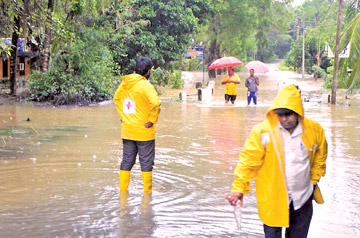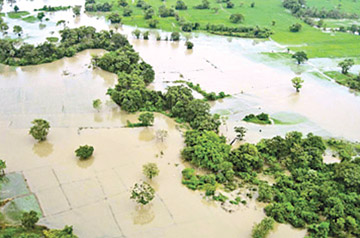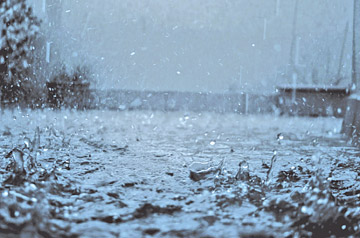Water-logged!
Last week's tempestuous weather is being blamed on
the El-Nino effect, but the danger is in how changing weather patterns
will affect paddy cultivation:
by Dhaneshi Yatawara
 |
| People wading
through flooded streets. |
 |
| Aerial view of
area submerged by flood waters |
 |
| |
Weather patterns have turned topsy turvy and unpredictable in Sri
Lanka in the past several years, but what is alarming is the effect it
will have on paddy cultivation, which solely depends on rainfall and the
North-East monsoon.
Emeritus Prof. W.L. Sumathipala, former head of the Sri Lankan
Climate Change Secretariat, said the altered weather patterns is an El
Nino effect.
"The reduction in the North-East monsoon rains will largely make
those areas drier affecting large scale rice production which will
obviously lead to serious environmental, social and economical
problems," Prof. Sumathipala said.
Prof. Sumathipala is currently serving as an advisor to the Ministry
of Environment. " El Nino can affect in different ways depending on its
strength and the geography of the country, even though it normally
relates to dry weather," he said.
Weather patterns have turned extremely chaotic to an extent where the
classic monsoon is not experienced anymore and the heaviest rains seems
to be falling during the inter-monsoonal period.Weather forecasts
predict the change as being due to disturbances in the atmosphere close
to Sri Lanka attributing it to El Nino effect. "Countries such as
Australia and India will experience the typical El Nino the study I
conducted a few years ago revealed that Sri Lanka being an island and
located at the edge of the El Nino signal, the country will encounter a
different weather pattern. That is what is happening now," Prof.
Sumathipala said, explaining the phenomena faced by Sri Lanka due to the
El Nino effect in 1974 -79 which created a wet climate while the cycle
created dry weather during the 1983 - 84 period.
Abnormal patterns
This weather pattern was normally seen in November with disturbances
and low pressure building up in the Bay of Bengal, he said.
"One has to clearly understand that El Nino is a short-term climate
change," he added.
A reduction in the North-East monsoon rains, which normally falls in
December till February is expected while an increase in the South-West
monsoon rains, from May to September, will follow. Explaining that this
since there is no warm weather with the continuous rain for the soggy
soil to dry up, he said this could lead to quick landslides even with
the slightest rain.
Director of the Department of Meteorology, S.R. Jayasekara, said
heavy rain could be expected within the next three months. "Though we
are at the tail end of the Southwestern monsoon, the intensity of
rainfall began changing with the recent atmospheric changes caused by
the cyclone in the Pacific Ocean, which later started moving towards
China. Atmospheric changes turned the winds in a southwesterly direction
and rain patterns may have changed due to this," he said. Jayasekara
admitted the El Nino cycle, over the Pacific ocean may have an effect
when it is strong and tends to spread towards Sri Lanka. "It is then a
severe El Nino," he added.
El Niño is a climate cycle in the Pacific Ocean with a global impact
on weather patterns.
According to the Department of Meteorology, rainy weather over the
island has reduced. However, several shower spells will occur in the
Western and Sabaragamuwa Provinces and in the Galle and Matara
Districts. Thunder showers are expected in several places elsewhere in
the afternoon. There may be temporary localized strong winds during
thunder showers. A study done by Shanthi de Silva, Senior Professor of
the Agriculture Engineering Faculty of the Open University of Sri Lanka
revealed that a 10% increase in the Southwest monsoon rain can be
expected according to data collected from 1999 till 2008.
The study had been done on the rainfall increase in the central
hills.
According to her, around 2050, the Southwest monsoon would bring a
further increase in rainfall to these areas. However, these areas would
experience a further decline in rainfall from the Northwest monsoon.
Veer
"The central hills would then face extreme weather patterns that
would veer from severe drought to floods during the two monsoons. The
latter could contribute to landslides and destroy the hill country
vegetable production," she explained. Prof. de Silva added that this
flood water can be stored to be used in the dry periods. The chaotic
weather conditions leading to natural disasters is the danger. Sri Lanka
has come a long way in managing natural disasters, though still facing
many challenges - now of a different kind, with the intensity of
changing weather patterns. Prof. Rohan Samarajiva, an expert in disaster
management said if rainfall continues, there must be disaster
preparedness regarding floods in areas along the rivers and landslides
in the hill country. Prof. Samarajiva was the founding chair of
LIRNEasia, the South Asian think tank which looks at disaster management
through a regional lens.
"Definitely we are in a much advanced stage than we were in 2004 with
regard to disaster management and preparedness. But we need to find the
right balance," said Prof. Samarajiva. He added that scientists should
be involved in making judgments based on scientific evidence. He pointed
out that scientists cannot take the final responsibility but the line
ministries and authorities at national and local levels must get
involved. Prof. Samarajiva said that this information should be
disseminated to the people, evacuation plans and safe evacuation
locations should be drawn out. "Sri Lanka has adopted well to cell
broadcasting being done in implementing this technology which is a life
saver during a disaster," said Prof. Samarajiva. Today, this option has
been activated by many local telecommunication companies. Software is
activated in Sri Lanka and is ready to be used at times of disaster," he
added.
Informing people
Yet, the cell broadcasting system is more relevant to disasters where
there will be less time for evacuation -such as cyclones and tsunamis.
"The flooding in rivers can be easily detected by fixing gauges in
the river and monitoring and there will be adequate time to inform
people and organise proper evacuation. But the most dangerous is a
landslide.
He added that science related to landslide detections have
significantly advanced within the past few years. The National Building
Research Organization (NBRO) is involved with early detection of
landslides and people are being currently educated on how to detect
landslides and when to evacuate.
"Whether the people will positively respond at the right time with
the technology given to them is the question and that needs to be a
prime concern of the disaster management authorities," Prof. Samarajiva
said. |

